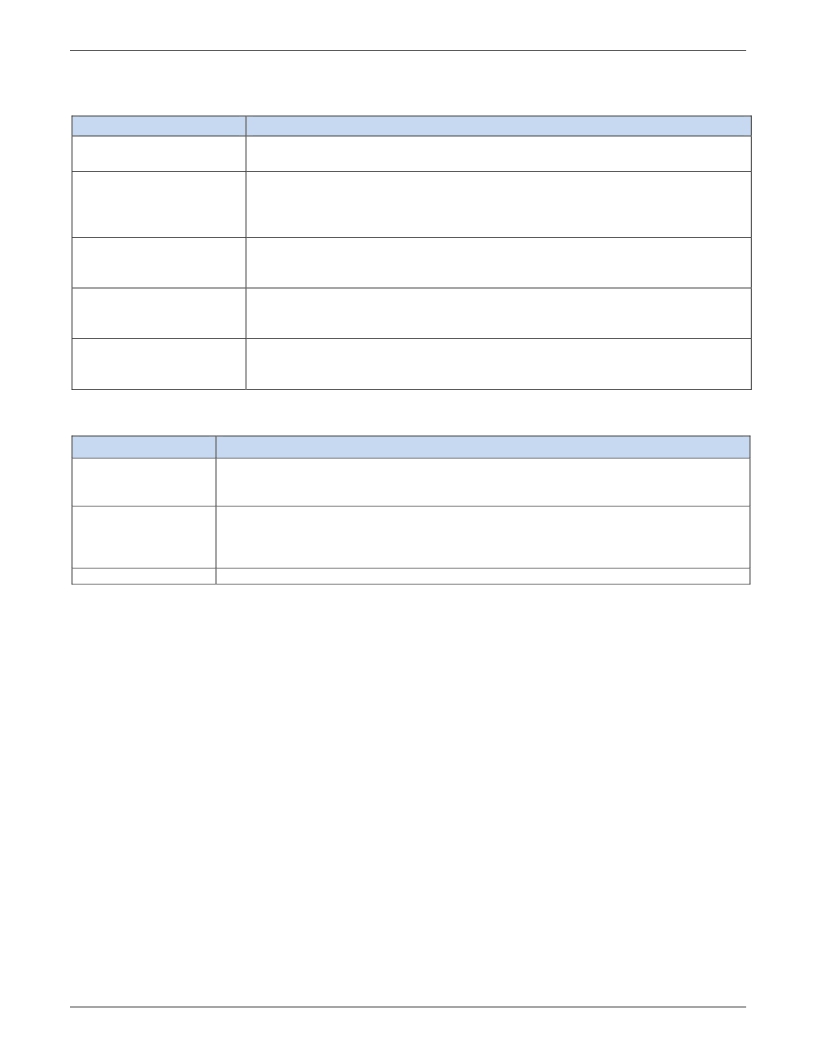- 您现在的位置:买卖IC网 > Sheet目录480 > MTCBA-C1-N3 (Multi-Tech Systems)MODEM CDMA RS232 DUAL
�� �
�
 �
�Chapter� 2� –� AT� Commands� Overview�
�Command� Types�
�Terminology Used to Describe AT Command Communication�
�Term�
�AT� Command�
�Result� Code�
�Extended� Reason� Code�
�Response�
�Unsolicited� Response�
�Definition�
�This� is� referred� to� as� a� command� from� the� host� application� to� modem� with� a�
�request� to� perform� a� service.�
�This� is� an� immediate� response� to� a� command,� informing� the� host� application�
�whether� the� execution� of� the� command� succeeded� or� failed.� The� strings� “OK”� or�
�“ERROR”� are� the� only� two� Result� Codes� available.� A� result� code� is� always�
�returned� after� an� AT� command� has� been� sent� to� the� modem.�
�If� enabled,� (see� AT+CMEE),� modem� responds� with� a� detailed� reason� code� string�
�in� addition� to� “OK”� or� “ERROR”.� The� reason� code� is� returned� before� the� result�
�code.� Extended� reason� codes� are� only� provided� when� the� result� code� is� ERROR.�
�A� response� contains� data� that� has� been� requested� via� an� AT� command.� A�
�response� is� returned� before� the� result� code� of� the� command.� A� response� is�
�provided� only� when� the� result� code� is� OK.�
�An� unsolicited� response� is� sent� by� modem� when� a� specific� event� occurs.� Some�
�unsolicited� responses� can� be� turned� on� and� off� via� AT� commands.� Some�
�unsolicited� responses� are� always� enabled� or� turned� on.�
�Three� Types� of� AT� Commands�
�Command� Type�
�Action� Command�
�Read� Command�
�Test� Command�
�Definition�
�Action� commands� are� used� to� perform� a� function.� Typically,� action� commands� are� used�
�to� change� the� value� of� a� setting� in� modem,� send� data,� or� perform� advanced� queries� that�
�require� input� data.�
�Read� commands� typically� end� with� a� “?”.� Most� read� commands� do� not� have� any� input�
�parameters;� however,� in� some� cases� an� input� parameter� provides� options� for� the�
�response� format.� The� read� commands� are� used� for� reading� values� of� certain� settings� in�
�the� modem.�
�Test� commands� are� not� supported� in� the� C1� modem.�
�Command� Format� and� Syntax�
�Alphabet�
�The� T.50� International� Alphabet� 5� (IA5)� is� used� in� this� manual.� Only� the� low-order� seven� bits� of� each� character�
�are� significant� to� modem.� Any� eighth� or� higher-order� bit(s)� are� ignored� for� the� purpose� of� identifying� commands�
�and� parameters.� Lower-case� characters� (IA5� values� from� 0x61� to� 0x7A)� are� considered� identical� to� their� upper-�
�case� equivalents� (IA5� values� from� 0x41� to� 0x5A)� when� received� by� modem� from� the� host� application.� Result�
�codes� from� the� modem� shall� be� in� upper� case.�
�All� commands� must� begin� with� the� characters� A� and� T.� If� the� A� and� T� are� not� received� by� the� software,� the�
�remaining� characters� will� not� be� processed.� This� is� important;� should� the� A� or� T� be� lost� in� communication� or� not�
�supplied,� none� of� the� characters� sent� to� the� modem� will� be� echoed� back� until� an� AT� sequence� is� observed.�
�Command-Line� Editing�
�The� character� defined� by� the� command� ATS5� in� chapter� 9.14,� (default:� backspace� [IA5� 0x08])� is� intended� to� be�
�interpreted� as� a� request� from� the� host� application� to� the� modem� to� delete� the� previous� character.�
�Any� control� characters� (IA5� 0x00� through� 0x1F,� inclusive)� that� remain� in� the� command� line� after� receipt� of� the�
�termination� character� are� ignored� by� the� modem.�
�Before� checking� for� other� characters,� the� modem� checks� characters� from� the� host� application� to� see� if� they� match�
�the� termination� character� (S3),� then� it� checks� to� see� if� they� match� the� editing� character� (S5).� This� ensures� that�
�these� characters� will� be� properly� recognized� even� if� they� are� set� to� values� that� the� modem� uses� for� other�
�purposes.� If� S3� and� S5� are� set� to� the� same� value,� a� matching� character� will� be� treated� as� matching� S3� (S3� is�
�checked� before� S5).�
�Multi-Tech� Systems,� Inc.� CDMA� C1� AT� Commands� Reference� Guide� (PN� S000478C)�
�9�
�发布紧急采购,3分钟左右您将得到回复。
相关PDF资料
MTCBA-C1-U-N2
MODEM CDMA USB 800MHZ 1.9GHZ
MTCBA-C1X-N2-NAM
MODEM CDMA 800MHZ 1.9GHZ
MTCBA-G-EN-F4-ED-GB/IE
MODEM GPRS QUAD EU/UK ETH INTFC
MTCBA-G2
MODEM GPRS CELLULAR SERIAL
MTCBA-H-EN2-NAM
WIRELESS ROUTER INTELLIGNT HSDPA
MTCBA-H3-U1
MULTIMODEM CELL WIRELESS MODEM
MTCBA-H4-EN2-GP-P1
ROUTER WIRELESS QUAD HSPA
MTCMR-G2
MODEM GPRS 850MHZ 1.9GHZ
相关代理商/技术参数
MTCBA-C1-N3-NAM
功能描述:MODEM CELLULAR RS232 DUAL CDMA RoHS:是 类别:RF/IF 和 RFID >> RF 接收器、发射器及收发器的成品装置 系列:MultiModem® Cell 标准包装:5 系列:MultiModem® iCell 功能:收发器,HSPA,调制解调器 调制或协议:GPRS,GSM,EDGE 频率:850MHz,900MHz,1.8GHz,1.9GHz 应用:- 接口:RS-232,USB 灵敏度:- 功率 - 输出:- 数据传输率 - 最大:7.2 Mbps 特点:- 电源电压:9 V ~ 32 V,USB 其它名称:881-1125
MTCBA-C1-U-N2
功能描述:MODEM CDMA USB 800MHZ 1.9GHZ RoHS:是 类别:RF/IF 和 RFID >> RF 接收器、发射器及收发器的成品装置 系列:MultiModem® Cell 标准包装:5 系列:MultiModem® iCell 功能:收发器,HSPA,调制解调器 调制或协议:GPRS,GSM,EDGE 频率:850MHz,900MHz,1.8GHz,1.9GHz 应用:- 接口:RS-232,USB 灵敏度:- 功率 - 输出:- 数据传输率 - 最大:7.2 Mbps 特点:- 电源电压:9 V ~ 32 V,USB 其它名称:881-1125
MTCBA-C1-U-N3
功能描述:MODEM CDMA USB 800MHZ 1.9GHZ RoHS:是 类别:RF/IF 和 RFID >> RF 接收器、发射器及收发器的成品装置 系列:MultiModem® Cell 标准包装:5 系列:MultiModem® iCell 功能:收发器,HSPA,调制解调器 调制或协议:GPRS,GSM,EDGE 频率:850MHz,900MHz,1.8GHz,1.9GHz 应用:- 接口:RS-232,USB 灵敏度:- 功率 - 输出:- 数据传输率 - 最大:7.2 Mbps 特点:- 电源电压:9 V ~ 32 V,USB 其它名称:881-1125
MTCBA-C1X-N16-NAM
功能描述:MODEM CDMA 800MHZ 1.9GHZ RoHS:是 类别:RF/IF 和 RFID >> RF 接收器、发射器及收发器的成品装置 系列:MultiModem® CDMA 标准包装:5 系列:MultiModem® iCell 功能:收发器,HSPA,调制解调器 调制或协议:GPRS,GSM,EDGE 频率:850MHz,900MHz,1.8GHz,1.9GHz 应用:- 接口:RS-232,USB 灵敏度:- 功率 - 输出:- 数据传输率 - 最大:7.2 Mbps 特点:- 电源电压:9 V ~ 32 V,USB 其它名称:881-1125
MTCBA-C1X-N2-NAM
功能描述:MODEM CDMA 800MHZ 1.9GHZ RoHS:是 类别:RF/IF 和 RFID >> RF 接收器、发射器及收发器的成品装置 系列:MultiModem® CDMA 标准包装:5 系列:MultiModem® iCell 功能:收发器,HSPA,调制解调器 调制或协议:GPRS,GSM,EDGE 频率:850MHz,900MHz,1.8GHz,1.9GHz 应用:- 接口:RS-232,USB 灵敏度:- 功率 - 输出:- 数据传输率 - 最大:7.2 Mbps 特点:- 电源电压:9 V ~ 32 V,USB 其它名称:881-1125
MTCBA-C1X-N3
功能描述:MODEM CDMA FOR VERIZON NETWORKS RoHS:是 类别:RF/IF 和 RFID >> RF 接收器、发射器及收发器的成品装置 系列:MultiModem® CDMA 标准包装:5 系列:MultiModem® iCell 功能:收发器,HSPA,调制解调器 调制或协议:GPRS,GSM,EDGE 频率:850MHz,900MHz,1.8GHz,1.9GHz 应用:- 接口:RS-232,USB 灵敏度:- 功率 - 输出:- 数据传输率 - 最大:7.2 Mbps 特点:- 电源电压:9 V ~ 32 V,USB 其它名称:881-1125
MTCBA-C1X-N3-NAM
功能描述:MODEM CDMA FOR VERIZON NETWORKS RoHS:是 类别:RF/IF 和 RFID >> RF 接收器、发射器及收发器的成品装置 系列:MultiModem® CDMA 标准包装:5 系列:MultiModem® iCell 功能:收发器,HSPA,调制解调器 调制或协议:GPRS,GSM,EDGE 频率:850MHz,900MHz,1.8GHz,1.9GHz 应用:- 接口:RS-232,USB 灵敏度:- 功率 - 输出:- 数据传输率 - 最大:7.2 Mbps 特点:- 电源电压:9 V ~ 32 V,USB 其它名称:881-1125
MTCBA-C-B-N12
制造商:Multi-Tech Systems 功能描述:CDMA,800/1900MHZ(BM)(BT)